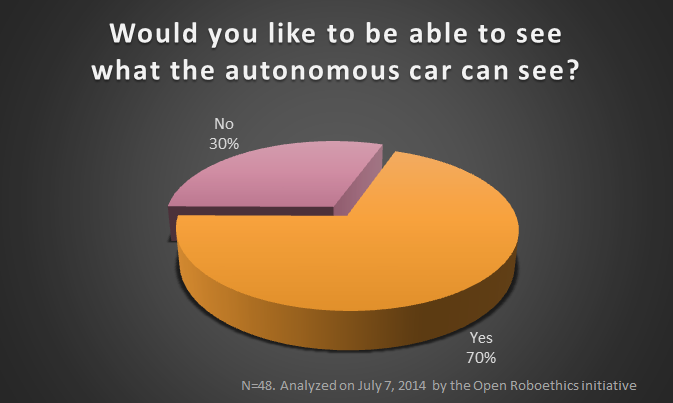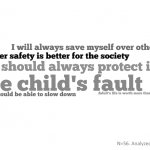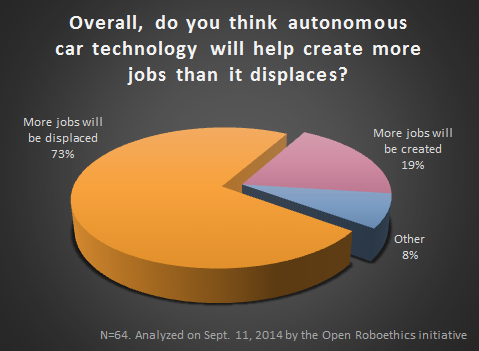Results: How would you like to interface with your car?
In our previous poll, we discussed a moral dilemma involving an autonomous car called the Tunnel Problem. In it, the car needs to decide whether to save a child’s life or its’ passenger’s. Obviously, such a scenario we hope no autonomous car will ever come across.
Moral dilemma or not, it is inevitable that an autonomous car will have to make decisions by itself and deviate from its planned course of actions — that’s what makes them autonomous in the first place anyway.
In such situations, there will be times when the car should alert its passenger about what is happening, and sometimes request assistance from a human decision-maker.
We became curious about how an autonomous car should alert its passenger(s). Of course, the designers of the autonomous cars will likely apply certain design principles and conduct tests to determine which interface works best for what scenario. But our curiosity was in people’s expectations and preferences.
When people imagine autonomous cars, do we imagine today’s conventional car with autonomous features, or a futuristic cars with more bells and whistles?
An autonomous car will have to deviate from its planned path or actions from time to time. How do you want an autonomous car to alert you?

Those of you who watched the 80’s TV series “Knight Rider” might remember the dialogues between Michael Knight and its super-car, KITT. Some of you might be more familiar with scenes between “Johnny cab” andDouglas Quaid (Arnold Schwarzenegger) in “Total Recall” (1990). In both, and many other films of the past, people have imagined being able to talk to cars.
Our participants seem to like this idea for the future of cars as well. In fact, 77% of our participants chose voice or sound as the preferred method for a car to alert its passengers upon deviation from planned actions. This choice is probably motivated not by our nostalgia for 80’s sci-fi or our love of Siri, but by more practical reasons. Since the car is doing the driving while the passenger snoozes away or otherwise preoccupied with other tasks, auditory alerts would probably be one of the most effective means to drawing the passenger’s attention. In fact, everyone who chose only one of the many options to answer this question chose sound, highlighting the possibility that sound is considered the most acceptable means for cars to alert its passengers.
Use of visual cues also got many votes (71%), while the use of haptic cues was supported by only 27% participants.
In what ways do you expect to be able to give instructions to an autonomous car?

In this question, we considering the opposite side of the communication — from the passenger to car. But the responses we got were quite similar to the one above. In fact the majority of people chose sounds (voice command) again, although the use of touch screen was the most popular.
Unsurprisingly, these are the same type of interfaces we use to interact with our tablets and smartphones today. This could mean that people imagine their interaction with autonomous vehicles to be more or less the same as their interactions with other technological devices we use everyday.
Some of the participants suggested an interesting idea of using a smartphone or a laptop to interface with the car. It turns out that this is an idea already being investigated. In fact, Bosch is developing a tablet interface for highly automated driving user experience. Researchers at Freie University of Berlin developed an iPad software solution which can remote control an autonomous car, called iDriver, and allows passengers to monitor the car’s sensor data. Even more important, both Apple and Google have unveiled plans to get their mobile operating systems (iOS and Android) — usually found in phones and tablets — running in cars.
But who cares how you interface with the car, or how the car interfaces with you?
Well, our data seems to tells us that people actually do care about user interface. In fact only the 2% picked the “I don’t care” option in the first question, and no one chose this option in the second question.
What parameters would you like to be able to set on your autonomous car?

The importance of Human Machine Interface is highlighted here, again. 69% of the participants said that they’d like to be able to set how their car alerts them. Equally popular answers included more functional parameters, such as the route the car takes to reach the destination (69%), whereas a perhaps futuristic option, namely “what kind of driver personality it conveys”, did not get very many votes (38%).
Would you like to be able to see what the autonomous car can see? Why?

One of the biggest differences between conventional cars and autonomous cars is the amount of sensing the car needs to do, and therefore the amount of data available. Our participants seem to be really interested in seeing the world through their car’s eyes… well, sensors. In fact, 70% of them answered positively to this question. Reasons for this choice can be summarized into 3 main groups:
- Diagnostics: Participants in this group said that they’d use the data to diagnose the car. (e.g., “to control, if anything is detected correctly”, “So I know that it can really drive for me and isn’t missing anything that can lead to accident.”)
- Coolness: Participants in this group wanted the visualization feature for the coolness factor (e.g., “I would like the option, mostly just because I think it would be cool.”)
- Curiosity: And some of us seem to be just curious about the technology (e.g., “It will give me a better understanding of the inner workings of the car. It will provide some transparency of the design, including the abilities/limits, of the car.”, “Because I’m curious to know what happens under the hood ”)
The majority of participants stated that this feature will increase their sense of control and reassurance (e.g., “Being aware of what the car is able to see would make me feel safe.”)
We think this is really important. One of the challenges automakers may face is the challenge of making people warm up to the technology, trust and accept it for use in everyday contexts despite inevitable accidents or hiccups along the way. Our poll results seem to be hinting at the fact that taking advantage of added features, such the visualization of the car’s surroundings, could help people feel safer riding in autonomous cars.
The results of the poll presented in this post have been analyzed and written by Camilla Bassani, AJung Moon, Shalaleh Rismani and Fausto Ferreira at the Open Roboethics initiative.








Pingback: Sources | Apps on wheels on smart highways
October 2, 2014